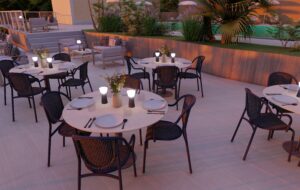

words Sam Jacob
Legoland’s depiction of London is being updated for the 21st century, and now the capital finally has a skyline to mimic.
Like some kind of satire-free Gulliver, I’m striding across a concrete landscape inside a large white tent. It looks like a desert marked out with spray paints. Stretched over a large geometric canyon is a Lego model of Tower Bridge. It looks as though a terrible toy town disaster has decimated London leaving a solitary landmark, like a cute version of Hiroshima.
This is, or soon will be, the new Lego MiniLand model – or cluster, as it is evocatively known in the trade – of London at Legoland Windsor. Offsite, the lords of architecture are being feted in Lego: Lord Rogers’ Lloyds building and Lord Foster’s City Hall are being carefully modelled by Ryan and Katie respectively. Outside Windsor, in Billund, Denmark (Legoland’s own ground zero), and in the Czech Republic, more recent London icons are being assembled: three Canary Wharf towers, the Gherkin, the Millennium Bridge. These new models will be added to the old London MiniLand buildings: Buckingham Palace, the Houses of Parliament, Big Ben, the BT Tower, Docklands Light Railway, Piccadilly Circus.
Transformations of the last ten years are reflected in changes to places like Trafalgar Square. There is a new Lego underground station, “Brick Park”. And a moment of geographic serendipity means Waterloo Station has been moved so that it neighbours MiniLand France – correcting the old cluster where Eurostar terminated at Charing Cross. A Lego Ken Livingstone might be made – perhaps insulting a Lego reporter from the Evening Standard, whose complaint might in turn see Lego Ken up before a Lego tribunal.
The whole thing has a kind of insane wonder about it. A tour de force of Lego transubstantiation – City Hall had to be built out of the 35 different types of silver Lego bricks. Legoland is an anathema to a certain school of architecture and sculpture. What if Louis Kahn asked a Lego brick what it wanted to be? And what would he make of it if the brick replied “I’d like to be a tie-in with a major motion picture release, ideally involving space.” What exactly would Carl Andre make of 13 million Lego bricks?
In the ten years since the original London cluster, the real city has itself become more plastic. The skyline has become more remarkable and London seems a place it is possible to remake. So it is that Docklands has now become an eastern anchor to the model. Perhaps in another ten years, as London continues to drift east, we’ll see a Lego Thames Gateway.
MiniLand has all of the surreality of any miniature village. But it’s extra odd because potentially – if you were stricken by an infantile obsession multiplied by a lottery win – it would be possible for you to reconstruct it all at home.
Model villages are not just models of real places, though they are obsessively concerned with looking like a scaled-down reality. They are also models of ideas, shrunk to fit comprehension.
Before the Renaissance, scale was not used to indicate distance. Instead, it represented other kinds of relationships: power and wealth. What it indicates here is different: MiniLand is a place where geography and scale have collapsed. The unrecognisable gaps are as important as the familiar things that have been modelled. The skill is in the invisible join lines, the edits and splices.
Alternatively, one could argue that the real world is becoming more like MiniLand – the depicted morphing into the depiction. Miniature villages create simultaneous sensations of omnipresence and disconnectedness, replicas of sensations familiar to anyone who has walked down Oxford Street. It might explain why both Will Self and Douglas Coupland have Honey I Blew Up The Author dust-jacket photos of themselves in model villages.
















